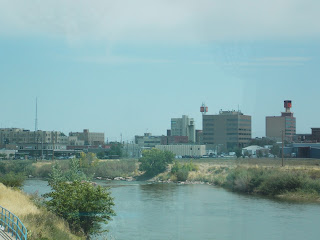We have been on the road several days now, heading
east. However, I still have some final
notes about Colorado which you
may find interesting. I had mentioned
the Grand Valley,
which had the wonderful peach orchards.
The older name of the Colorado River was the Grand
River, hence there is Grand Junction
and Grand Valley. And I have more more item here about Grand Junction.
There was one sculpture in downtown Grand
Junction which I did not mention, however, since then
we have learned that the sculpture of James Dalton Trumbo may be of interest to some people as there is a movie coming out about
him. Sign near this artwork notes that he was “Grand
Junction’s most famous export”. He was an academy-ward winning screenwriter,
author, playwright, “erudite firebrand and blacklisted member of 1947s infamous
10”. Some of his more famous films
included Spartacus and Roman Holiday. He
would write forever in his bathtub. It seems that a movie of his life would be interesting to see!
One last picture of Colorado. I tried to soak in the high red rock views
before we hit the
Plains and Midwest. We took north Colorado
highway 13, and once in Wyoming,
interstate 80.
At our first campground in Wyoming
we met a young couple and their tiny home.
They had just purchased it and were moving it to northern Ca. where they
planed to live. That night was going to
be their first night in their new home.
I watched the man hook up his home to water and electric- just like we
do with our motor home. He said his pick-up truck had come to close to over-heating towing the home over the mountains. Like us, they had taken a route north through Colorado to avoid crossing the Continental Divide.
Coming into Casper
we began seeing portions of the North Platte River, pictured above. I did not think I would enjoy seeing a larger town once again. We had gone only through small towns up to this point, including Lost Springs with a population of four! Crossing the plains of Wyoming I could not help but think of the early pioneers crossing the same land in covered wagons. Occasionally we would see roadside markers denoting areas of the trails they once used- including the Oregon Trail. Other roadside markers noted places of Native Indian battles. In Nebraska we stayed Wednesday night at Fort Robinson park, near Crawford, Ne. It had been a military fort until after World Wat ll, and now is quite an extensive museum with with many of the original buildings restored. Walking over its grounds I could not shake the feeling that it is a sad place. In 1878 149 North Cheyenne Indians (the number included women and children) were imprisoned in the cavalry log barracks. They were given inadequate food, water or heat with the plan to force them into submission. In January of 1879 they tried to escape, the soldiers pursued them until all were either captured or killed. I know, there is a lot more history in the fort over its 40 some years of existence than the one incidence with Indians, but once I learned of that story I did not care to walk around the fort any longer. Some of the buildings of the fort are pictured below.
We are now in North Sioux City, South Dakota. Hard to believe that we were in Colorado four days ago. And as we came into Sioux City, we crossed the Missouri River- which made me realize how much closer we were getting into our own home territory of Missouri.




















































